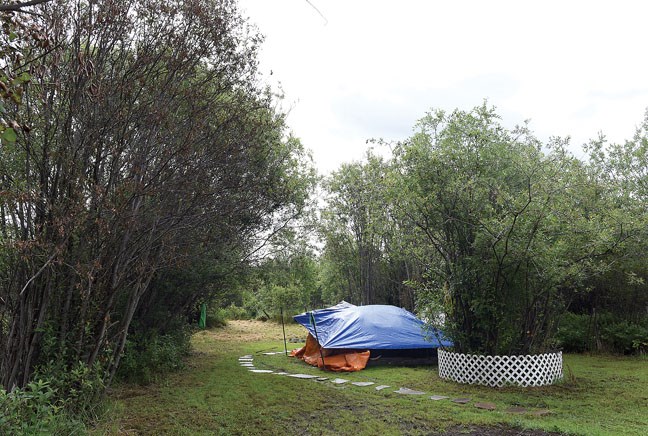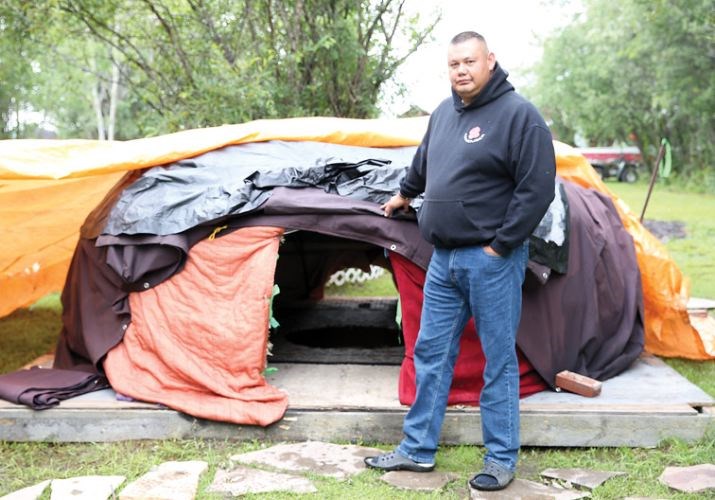At the back of Jason Gillis' Blackburn property birds chirp high in the branches above his new sweat lodge, its shape built on the arching backs of 16 willow branches and draped in two dozen blankets.
A stone path curves around the side, guiding his steps to an opening. He lifts one edge of the blue tarp and crawls his six-foot-four frame inside.
Leaves tickle the top of his head as does the blue fabric tied high to signify sky. The Prince George RCMP constable hunches over and stares at the pit in the heart of the healing hut he helped create. Reconnecting with his culture has helped the 43-year-old fight off the trauma that took hold of his life for so many years and the lodge has been a path toward himself again.
"The only thing you see are the red rocks from the fire, completely red, and you end up sitting with it. It gives you time to reflect on yourself and what you need to do," he says. "You have to meditate basically. One of the elders would always say: 'Your eyes can truly not see until they're in the dark,' and it really made sense with me.
"I have to live with the beast of (post-traumatic stress disorder), or the burden of it, but I don't have to let it control my life."
That was the genesis of this project: to create an oasis for himself.
But it's far from his alone. The personal lodge has another purpose as a space for first responders struggling with similar trauma and seeking alternate ways to find relief or comfort even with undiagnosed conditions.
"I find a lot of the first responders are afraid to ask for help because they'll be shunned so it's one of the things where I see the benefit it's given (me)," says Gillis, who has funded the lodge on his own - several thousand dollars - repurposed household items, like the rugs from his basement, and also received blankets from the Prince George Humane Society.
"I think I'm at that point in my recovery where I need to share that with other people. If they're able to find one thing about themselves that's good and work on that. That will eventually bring that circle into balance."
Almost a month ago, he finished the lodge and offered the first sweat to five men, a first for most. Fourteen have already expressed interest and Gillis wants to offer a women-only sweat too.
"There's nothing specifically for first responders and nothing about education," says Gillis, who is the RCMP's first urban Aboriginal liaison officer, a new position created last year. "It's one of the things where the silence sometimes is the worst thing but it's also the best thing. This was our medication."
Listen to Jason Gillis describe his sweat lodge and experience with PTSD:
For a long time, a different silence kept Gillis from asking for help.
The September day the World Trade Centre Towers fell in 2001, Gillis was in his own hell, dragged along First Avenue by a stolen pick-up truck - its drugged-up driver showing no sign of slowing down. As Gillis relives his PTSD's origin story, his words are slow and his voice calm. The events all mesh together: The white Ford F-150 swerving at him, and in a split second his arm caught in the driver's-side window.
The failed attempt to jump, and flying from the vehicle as it crashed into the train tracks past Victoria Street. The fear.
"I guess that's really when I started having symptoms of PTSD except I refused to talk about it."
Two years later, transferred to Chilliwack, another traumatic chase, another horrific injury. At first, the back injury was so severe doctors said he wouldn't walk again. Now the psychiatrist called his PTSD "severe."
But that June 2003 Gillis was still a decade away from true recovery. For years after, he felt lost and his thoughts turned to suicide. Alarmingly the whispers became reality as he planned how to do it, and which room in his home would cause his wife, baby and young son the least pain should they find him. One day his son walked in on an attempt.
"It took 10 years of the struggle of not wanting to live, not wanting to do things, of just being a robot, really. I would go to work because I knew I had to act like A, B, and C, that's it. I never smiled," he said, but that act didn't work in his personal life. "I couldn't be a father at home because you couldn't do A, B, and C at home. If I hadn't have asked for help I probably wouldn't be here."
Although a discussion exists around mental health and trauma, to Gillis it still feels far too quiet.
"With my PTSD the biggest thing was, it was taboo: You're not allowed to have it, not allowed to talk about it," Gillis said.
But in summer 2013, a two-month stint at Ontario's Homewood Health Centre's Program for Traumatic Stress Recovery started him on the path he walks today.
There he started doing smudges three and four times a day, often joined on this cleansing ritual by members of the Canadian Forces.
"They'd see me walk away with my feather and my tobacco and my shell and asked what I was doing and I told them. Eventually, I had about 20, 25 people doing smudging with me," he says.
"I came back (to Prince George) and I really started to fall back into my culture."

Gillis is grateful the Lheidli T'enneh approved the lodge in its territory - making his one of about four in the city, he says.
Gillis is from Saikuz First Nation or Stony Creek - also a Carrier Nation - south of Vanderhoof. It's customary to follow certain protocol and ask for permission to build the sacred structure.
It helped that Lheidli elder Marcel Gagnon guided him through its creation.
"This whole thing is all about Jason and his healing journey and I'm just honoured to be a part of it, to show him how to build a lodge and what the willows mean and why they're put in the ground," says Gagnon, who is also Gillis' father-in-law. "Some will teach each one has a meaning, like a teepee pole: respect honour, love, wisdom."
But first the rocks - as many as 28 for the Blackburn lodge - are heated in a fire for hours outside the domed hut before they're carried in by pitchfork.
"When Jason splashes those hot grandfathers, what they're offering us is a cleansing, a physical cleansing and spiritual cleansing. In return we're offering them water to quench their thirst I suppose," explains Gagnon.
"Those prayers get taken up in the steam... and the real painful stuff goes into the willows and is brought back into the earth.
"It becomes a very powerful, powerful place after a while because there's a lot of pain that's left in here."
The Canadian government's ban on the traditional practice extended into Gagnon's lifetime, a vestige of the Indian Act, which included bans on potlatch and sun dances.
It's partly why Gagnon prefers the sometimes secretive practice to exist openly, though Gillis' lodge is an example of a personal rather than traditional people's lodge.
The sweat lodge - and many indigenous ceremonies - were outlawed until 1951, after a revision to the Indian Act
"In Canada, the integrity of existing Indigenous healing systems was interrupted when the government outlawed First Nations traditional medical practices and ceremonies," wrote Julian Robbins and Jonathan Dewar in The International Indigenous Policy Journal in 2011.
"To think for years we weren't allowed to practice the sweat lodge, we weren't allowed to practice our potlatches. We weren't allowed to talk our languages," says Gillis, who is adamant his lodge be open to all backgrounds.
"When you start to sweat, there is no colour in here, doesn't matter if you're black or white, none of that matters. It forces you to take any of those biases and put them aside and that's the one thing I love about the lodge is, it helps us find our faults as well."
The colours and their orientation inside carry meaning. Green at the base for mother earth. The door faces east, where everything begins, he says.
"The sun rises from the east, it starts giving new birth to light, to life. North, land of the white, colour is white because that's where the snow goes. South is red because that's where everything starts to come again."
The 16 arching willows, evenly spaced, remind him of the balance he seeks.
"The easiest way to describe to people about PTSD was using the healing circle, the medicine wheel," he says. "It doesn't matter how many colours - red, white, yellow, blue or black - doesn't matter how many pieces of the pie, as long as every piece is the same size and your life is balanced."
There are four rounds to the sweat, which can take about an hour, and each is specific Gillis says. Throughout, Gillis looks to the red rocks - the grandfathers - to guide his thoughts.
"I think about myself, I think about what I need to do to stay balanced, I think about my medicine wheel," he says.
"I don't ask for a lot of things for myself because truthfully I'm very lucky. I'm very lucky to be alive and (have) my humble little lodge."



